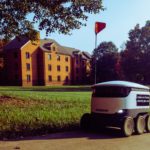 A few years ago as companies like Starship Robotics started testing their delivery robots, it seemed inevitable that the future of delivery would be autonomous. Of course, while the Covid pandemic created the perfect environment for such a future, what with the tremendous rise in online commerce and the clear need for delivery services that wouldn’t be exposed to or spread the virus, the reality was that the pandemic instead saw a surge in recruitment for human drivers.
A few years ago as companies like Starship Robotics started testing their delivery robots, it seemed inevitable that the future of delivery would be autonomous. Of course, while the Covid pandemic created the perfect environment for such a future, what with the tremendous rise in online commerce and the clear need for delivery services that wouldn’t be exposed to or spread the virus, the reality was that the pandemic instead saw a surge in recruitment for human drivers.
The change did prompt the creation of small, often automated, micro-fulfillment centers that allowed retailers to fulfill orders quickly. A recent study from the University of Michigan explores what these changes might do to the carbon footprint of deliveries, especially if they’re ultimately fulfilled by robots.
“This research lays the groundwork for understanding the impact of e-commerce on greenhouse gas emissions produced by the grocery supply chain,” the researchers explain. “We also emphasize the important role that consumers can serve in reducing emissions through the use of trip chaining and by making carefully planned grocery orders.”
Sustainable delivery
The researchers modeled the emissions produced for a simply 36-item grocery order that was transported to customers via a wide range of delivery pathways, including both traditional and e-commerce methods.
Interestingly, the most emissions were produced when the order was collected in-store via an internal combustion engine pickup truck. This then understandably fell when the customer used an electric vehicle to collect their shopping.
By contrast, all of the home delivery options were considerably lower in terms of emissions than the combustion engine collection in store. Of the automated options, drones were effective but their limited capacity meant that the size of the basket was relatively small. The sidewalk robot was able to fulfill the full 36-item order and was able to deliver with minimal emissions.
Emissions ranged from the highest with in-store pickup with an internal-combustion engine down to grocery-delivery services, which could see a reduction of up to 65% on the SUV pickup. Emissions were also influenced by the frequency of the shop and trip chaining, as reductions in the frequency of a half would cut emissions by 44%. Similarly, trip chaining would cut emissions by around half.